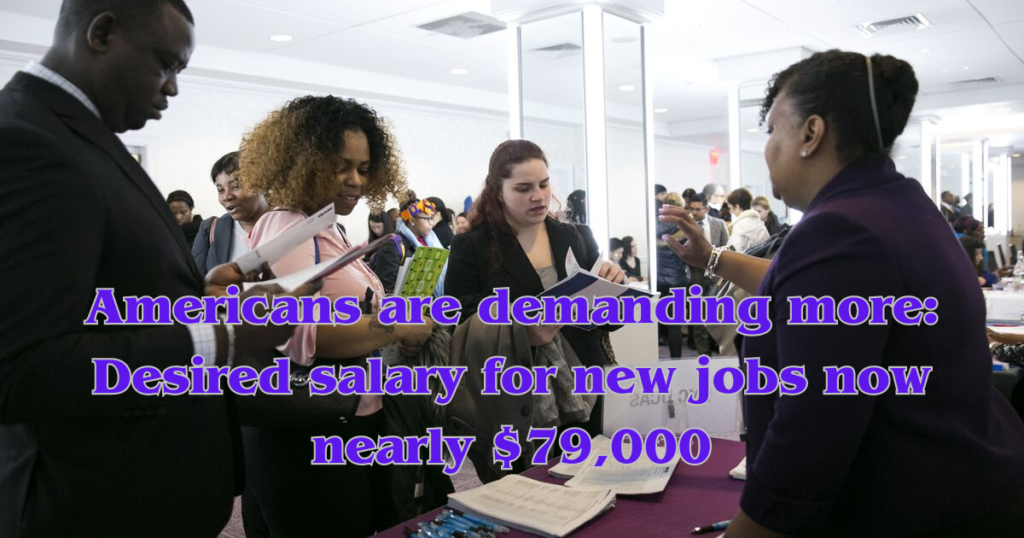Table of Contents
The Soaring Aspirations of American Job Seekers
In a sign of shifting job market dynamics, Americans’ salary expectations for new jobs reached their highest point in nearly a decade, hitting levels not seen since March 2014, when the New York Federal Reserve began monitoring this data. The figures indicate a notable change in the employment landscape, with the lowest annual wage respondents are willing to accept for a new position surging to $78,645. This significant increase marks a substantial climb from $72,873 in July 2022 and $62,194 in July 2019, pre-COVID-19. Worth noting is that this year-over-year increase was most pronounced among respondents aged 45 and older. Moreover, a gender divide is evident, with men aiming for an average annual salary of $91,048, in contrast to women’s expectations, which hover around $66,068.
Wage Growth: A Central Element in the Battle Against Inflation
Wages have become a focal point in the Federal Reserve’s battle against inflation. In June, Fed Chairman Jerome Powell underscored the importance of taming wage inflation as a key component of achieving the central bank’s 2% inflation target. This comes against the backdrop of the consumer price index for July registering at 3.2%, a notable uptick from June’s 3%. There is indeed a palpable gap between the desired annual salary of $78,645 for job transitions and the average income of $69,475 reported over the past four months. Nonetheless, this discrepancy still reflects a considerable improvement from the average $60,764 earned just a year ago.

The Wage-Price Spiral: A Delicate Balancing Act
The question arises: How does wage growth contribute to inflation? When businesses face rising wage expenses, they often respond by increasing their prices, which, in turn, prompts workers to demand higher wages to sustain their spending power. This cyclic phenomenon is commonly referred to by economists as the “wage-price spiral.” It is crucial to note that advocating for wage stagnation is not the solution. Powell emphasizes that wages will continue to rise, albeit at a level that aligns with a 2% inflation rate over time. However, Powell did not specify the exact threshold that would align with the Fed’s inflation goal, indicating that the current conditions have not yet met the desired equilibrium.
Analyzing Wage Growth Trends
In this context, it’s vital to examine the wage growth trends. The Atlanta Fed’s wage growth tracker indicates that in July, wage growth stood at 5.7%, a slight uptick from June’s figure. For job changers, this tracker reached 6.4% in July, up from 6.1% the previous month. For those remaining in their current positions, the tracker remained steady at 5.4%, unchanged from June.
Cooling Down Wages: A Possible Fed Strategy
How can the Federal Reserve curb the surge in wages? One approach is to cool down the labor market, and data from the New York Fed suggests that this may already be happening. The percentage of job seekers in the previous four weeks dropped to 19.4%, a significant decrease from the 24.7% reported a year ago. Simultaneously, the likelihood of job switching declined from 11% to 10.6% according to the survey.
Changing Perceptions of Job Offers
Furthermore, expectations regarding job offers have evolved. The percentage of individuals expecting to be offered a new job dropped to 18.7% from 21.1% year-on-year. Similarly, the average expected likelihood of receiving multiple job offers in the next four months decreased to 20.6%, down from 25.7%, as reported by the New York Fed.
A Rising Concern: Unemployment Expectations
In a somewhat disconcerting development, 3.9% of respondents now anticipate unemployment, a notable increase from the 2.3% reported in July 2022. This marks the highest level seen since March 2020, underscoring a growing concern within the labor market.
In conclusion, the American job market is witnessing a transformation in salary expectations and employment dynamics. As wage demands continue to rise, striking a balance between wage growth and inflation control becomes an increasingly complex challenge for policymakers, particularly the Federal Reserve. The path ahead will likely require nuanced strategies to navigate these evolving labor market dynamics effectively.
Unlocking the Magic of Freelance Writing: Your Path to $250/Hour Riches!




